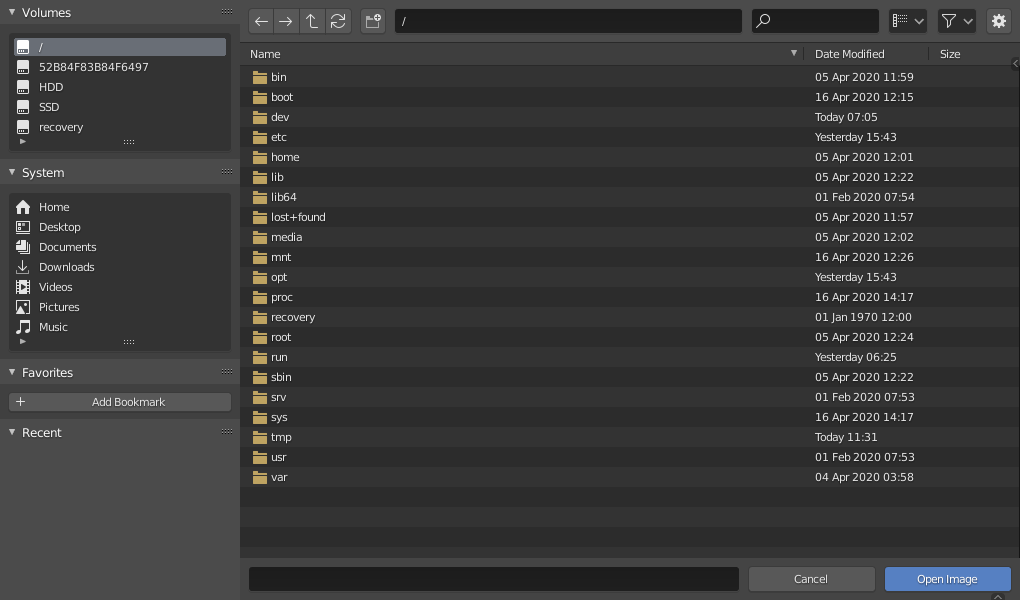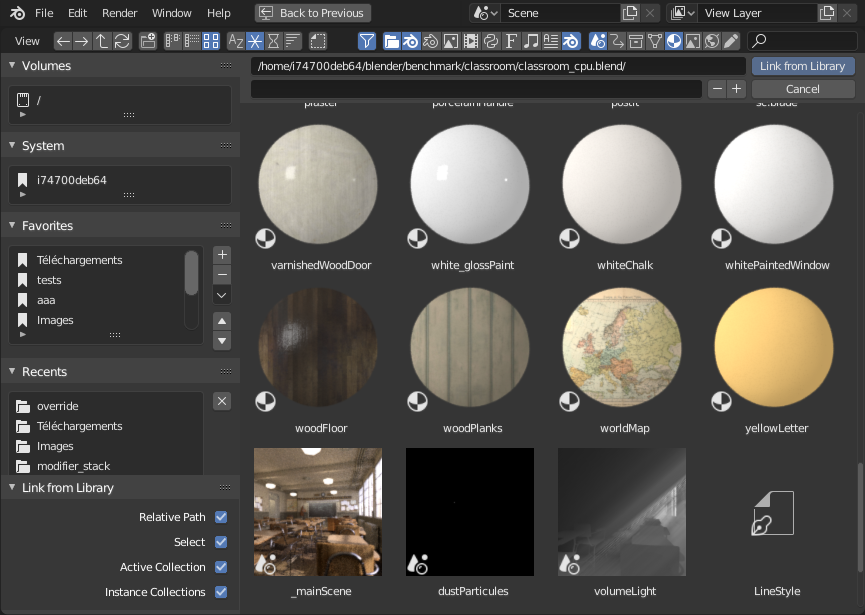Navigateur de fichiers
The File Browser is used in all the file-related operations. These include:
Ouverture et sauvegarde des fichiers blend.
Browsing inside other blend-files, when appending or linking data-blocks, see Linked Libraries.
Import depuis / export vers d’autres formats de fichier.
Picking new locations for existing file paths (images, videos, fonts…).
The most common way to use this editor is through modal operators (like opening or saving a blend-file). The File Browser will appear in a new window, waiting for the operation to complete, and then close returning the main window.
You can use the File Browser as any other editor type, to browse through the file system. The main purpose of this is to be able to drag-and-drop from the File Browser into other editors.
Images into the 3D Viewport (to set as background or apply as material texture).
Media files into the Montage vidéo.

Le Navigateur de fichiers.
Interface
Région principale
The main region of the File Browser acts similar to the file browser built into you operating system. The region contains an array of files, folders, or internal blend-file data in a grid or list of items. Navigating, selecting, and editing of these items works just as it would in your operating system’s file browser.
Aperçus
Dans son mode d’affichage Thumbnail, le Navigateur de fichiers prend en charge de nombreux types d’aperçus. Ceux-ci comprennent :
Formats d’image et de vidéo
Fontes
Fichiers blend
Blocs de données internes
In order to get previews for data-block, there previews must be generated. See Blend-files Previews for how to generate and manage Blender data previews.

Le Navigateur de fichiers en mode Thumbnail.
File Path Region
The File Path is above the main region and can aid in navigating and adjust how items are displayed.
- Previous Folder Backspace, Alt-Left
Move to previous folder (in navigation history).
- Next Folder Shift-Backspace, Alt-Right
Move to next folder (in navigation history).
- Parent File P, Alt-Up
Remonter au dossier parent.
- Refresh File List R, NumpadPoint
Réactualiser le dossier courant.
- Create Directory I
Will ask you to confirm and create a new directory inside current one, scroll to it in the main view, and let you enter its name.
- File Path Ctrl-L
Text field for the current folder path. Tab will auto-complete an existing path. If you type a nonexistent directory path, you will be prompted to create that new directory.
- Search Ctrl-F
Filter items by name. The wildcard
*will match anything, e.g.bl*erwill match bothblenderandblogger. There is always an implicit wildcard at start and end of the search text, soblenderwill also matchtest_blender_file.blend. This field can also be used to filter some specific file extension (e.g..pngwill list all PNG files).
- Mode d’Affichage
Controls how files are displayed.
- Vertical List:
Affiche les fichiers et les dossiers dans une liste verticale.
- Horizontal List:
Affiche les fichiers et les dossiers dans une liste horizontale.
- Thumbnails:
Affiche les previews (les aperçus).
Paramètres d’affichage
- Display Size
The size of the thumbnails, or the width of the columns.
- Recursion
Le nombre de niveaux de dossier à afficher à plat en même temps.
- None:
List only the current directory content.
- Blend File:
Répertorie tout le contenu d’un fichier blend (disponible uniquement lors de la liaison ou de l’ajout de blocs de données).
- One Levels:
Liste le contenu de tous les sous-répertoires, un niveau de récursivité.
- Two Levels:
List all subdirectories” content, two level of recursion.
- Three Levels:
Liste le contenu de tous les sous-répertoires, trois niveaux de récursivité.
Indication
L’affichage de plusieurs niveaux de dossier à la fois peut être pratique pour par ex. voir toute votre collection de textures, même si vous les avez rangées dans un ensemble soigné de dossiers pour éviter d’avoir des centaines de fichiers en un seul endroit.
In the Append/Link case, showing the content of the whole blend-file will allow you to link different types of data-blocks in a single operation.
Avertissement
The more levels you show at once, the more time it will take to list them all (typically, it will be exponential, showing three levels at once may take three orders of magnitude more time to be fully listed).
- Sort By
Trie les éléments selon l’une des quatre méthodes :
- Name:
Trie les fichiers par ordre alphabétique.
- Extension:
Trie la liste des fichiers par extension/type.
- Modified Date:
Trier les fichiers par heure de modification.
- Size:
Trier les fichiers par taille.
Paramètres de filtrage
On the right side of the file path are the filtering options. The toggle with the funnel icon controls whether filtering is enabled or not.
- File Types
Filtre les fichiers par catégories, comme les dossiers, les fichiers blend, les images, etc.
- Blender IDs
Lors d’ajout ou de liaison, vous pouvez également filtrer par catégories de bloc de données, comme les scènes, les animations, les matériaux, etc.
Région d’exécution
- File Name
Text field to edit the file name and extension. When saving, if the background is red, a file with same name already exists in the folder. Tab will auto-complete to existing names in the current directory.
- Increment Filename
-,+ Removes/Decreases or adds/increases a trailing number to your file name (used e.g. to store different versions of a file).
- Increment Filename
- Cancel Esc
Cancels the file selection (and the underlying operation), and closes the File Browser. Using the Back to Previous button in the Topbar will have the same effect.
- Confirm Entrée
The main button to validate the operation, which defines its name. Double-clicking on a non-directory item will have the same effect.
Source List Region
The left region displays different ways to quickly access some directories. The region is divided into separate panels each containing a UI List of directories. Clicking on one of the directories will immediately navigate to that folder.
Volumes
Contains all OS-defined available volumes, e.g. drives or network mounts.
System
Contains OS-defined common directories, like the main user folder…
Bookmarks (signets)
Contains folders that you want to be able to access often without having to navigate to them in the File Browser. To the right of that list are buttons to perform basic management actions on your bookmarks, e.g. add/remove an entry, move it up or down in the list, etc.
Recent
Contains recently accessed folders.
The X button to the right allows you to fully erase this list.
Vous pouvez contrôler le nombre de dossiers apparaissant dans cette liste avec le champ numérique Recent Files de l’onglet Save & Load dans les Préférences.
Région des options de l’opérateur
The right region shows the options of the calling operator. Besides common actions listed below, many import/export add-ons will also expose their options there.
- Open, Save, Save As Blender File
- Open, Replace, Save As Image
- Link/Append from Library
Voir Bibliothèques liées.
Pour l’option commune :
- Relative Path
Voir Relative Paths.
Région de l’entête
The header only contains two menus, one with you standard editor View controls and the other to list a few Selecting operators for the sake of discoverability. Often it is hidden as most of the functionality is contained in the regions described previously.
Sélection
- Select
Both LMB and RMB clicks work. Holding Shift will extend the items selection.
- (De)select All A
Toggles selecting all files.
- Dragging (Cliquer-glisser)
Le glisser avec LMB démarre une sélection par boîte.
Note
You can always select several entries in the File Browser, the last selected one is considered as the active one. If the calling operation expects a single path (like e.g. the main blend-file Open one), it will get that active item’s path, other selected ones will just be ignored.
Touches fléchées
Il est également possible de sélectionner/désélectionner des fichiers en les “parcourant” avec les touches fléchées :
Just using an arrow key, the next file in the chosen direction will be selected and all others deselected.
Holding down Shift while doing this does not deselect anything so it extends to the selection, plus it allows to deselect files by navigating into a block of already selected ones (minimum two files in sequence).
Holding down Shift-Ctrl further selects/deselects all files in between.
Si aucun fichier n’est sélectionné, la navigation par touche fléchée sélectionne le premier et le dernier fichier du dossier, selon la direction de la flèche.
If you select a directory and hit Return, you will go into that directory
(and highlighting “parent” .. entry will bring you up one level).
Édition
- External
Utiliser le système d’exploitation pour effectuer une action sur le fichier ou le répertoire. Les options répertoriées ci-dessous peuvent ne pas être disponibles sur tous les systèmes d’exploitation.
- Open:
Ouvrir un fichier.
- Open Folder:
Ouvrir le dossier.
- Edit:
Éditer le fichier.
- New:
Créer un nouveau fichier de ce type.
- Find File:
Rechercher des fichiers de ce type.
- Show:
Afficher ce fichier.
- Play:
Jouer ce fichier.
- Browse:
Parcourir ce fichier.
- Preview:
Prévisualiser ce fichier.
- Print:
Imprimer ce fichier.
- Install:
Installer ce fichier.
- Run As User:
Exécuter en tant qu’utilisateur spécifique.
- Properties:
Afficher les propriétés du système d’exploitation pour cet élément.
- Find in Folder:
Rechercher des éléments dans ce dossier.
- Command Prompt Here:
Ouvrir une invite de commande ici.
- Delete Files Delete, X
Supprimer les fichiers ou répertoires actuellement sélectionnés en les déplaçant vers la “trash” (corbeille) du système d’exploitation.
Notez que sous Linux, la suppression de répertoires nécessite KDE ou GNOME.
- Rename F2
Change the name for the currently selected file or directory.